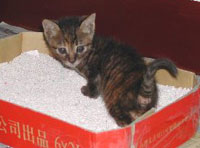养猫是人生一大乐趣,但是怎么处理猫咪的排泄物实在是太费心了。幸好世界上有“猫沙”这种东西,给养猫的人省掉不少麻烦。不过,你没有想过“猫沙”是谁发明的呢?下面这篇文章就来为您介绍一下猫沙的历史。
 In January of 1948, an enterprising young man named Ed Lowe, the heir apparent to his family's coal, ice, andsawdustsupply company, gave the name "Kitty Litter" to a product manufactured by his family, known as Fuller's Earth.
In January of 1948, an enterprising young man named Ed Lowe, the heir apparent to his family's coal, ice, andsawdustsupply company, gave the name "Kitty Litter" to a product manufactured by his family, known as Fuller's Earth.
The product consisted of kiln-dried clay, and its intended use was as a non-flammable, industrial absorbent. Ed aspired to expand his family's business by marketing the tinynuggetsof clay to chicken farmers as nesting material for their chickens, but failed in his attempts to do so.
At the same time, Kay Draper, of Cassopolis, Michigan, sought sand for her cats' litter box, as the pile she drew from had frozen solid in the cold, Midwest winter, and the ashes she used from her fireplace, out of sheer desperation, proved to create quite a mess. The sawdust she tried, though much tidier, did not work much better.
A frazzled Kay opted to visit the Lowe factory, in hopes of obtaining some sand, where she encountered the eager and youthful Ed Lowe. Sensing an opening, Ed gave his pest sales pitch on the merits of using Fuller's Earth as an absorbent for cat waste instead of using sand. Kay bit, loved the product, gave Ed freeword-of-mouthadvertising, and came back for more. She also sent Ed a faithful following of feline owners requesting Fuller's Earth for their cats.
Ed took the initiative, packaged the dried clay in ten 5-pound paper bags, which he labeled "Kitty Litter." Even at the bargain basement price of $0.65 per bag, Ed could not sell his bags, so he decided to give them away for free to a local pet shop. The shop owner's customers so liked their free samples of Kitty Litter that they were willing to open their change purses to pay for it.
Enterprising Ed took his feline phenomenon on the road, targeting pet shops and cat shows in hopes of promoting his pet project. Eventually, the seed that he planted in Cassopolis, Michigan took root, and Kitty Litter sparked a feline frenzy. Sales boomed, and a private investment group by the name of Golden Cat made Ed an offer he could not refuse…$200 million dollars plus stock options. Naturally, Ed accepted the offer, retired, and generously established a foundation bearing his name to help other entrepreneurs achieve the same fame and fortune he did with his granules of clay.
Ed died in 1995, leaving behind a legacy of cat litter that dominates the market at 55%, and sparking an industry of cat foods, toys, and otherparaphernaliacatering to the cat lover. His persistence, ingenuity, and flexibility should serve as a lesson to all that even nuggets of clay can be transformed into nuggets of gold with perseverance, patience, and a positive attitude.
sawdust: 锯屑
nugget: 小块
word-of-mouth: 口头的
paraphernalia: 随身用具
(英语点津李艳洁编辑)